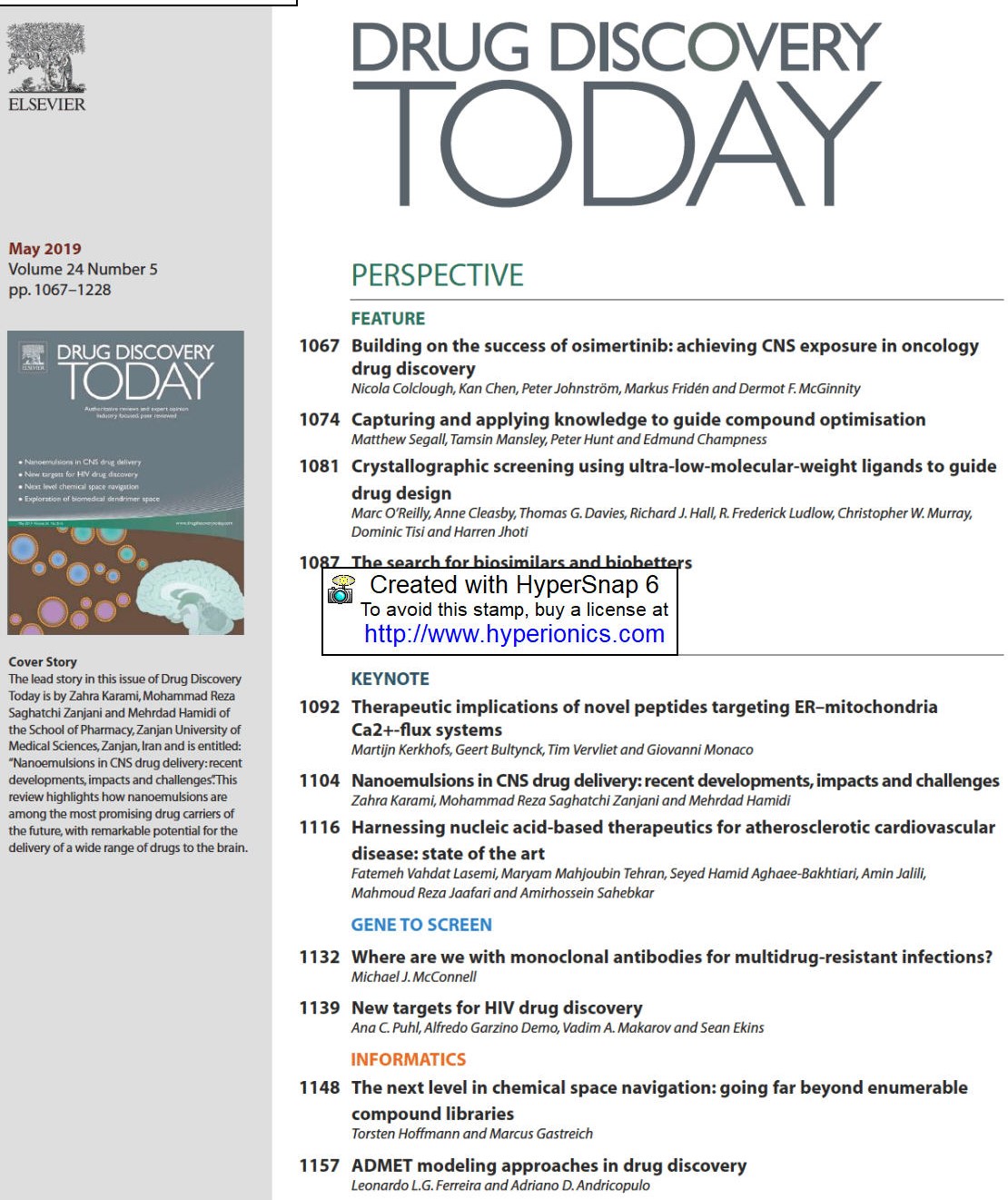博文
最新一期《今日药物发现》
|||
最新一期《今日药物发现》
诸平
今天收到的最新一期的《今日药物发现》(Drug Discovery Today,2019, 24(5):1067-1228.详见下面的封面说明:)
May 2019
Volume 24 Number 5 pp. 1067–1228

Cover Story
The lead story in this issue of Drug Discovery Today is by Zahra Karami, Mohammad Reza Saghatchi Zanjani and Mehrdad Hamidi of the School of Pharmacy, Zanjan University of Medical Sciences, Zanjan, Iran and is entitled: “Nanoemulsions in CNS drug delivery: recent developments, impacts and challenges”. This review highlights how nanoemulsions are among the most promising drug carriers of the future, with remarkable potential for the delivery of a wide range of drugs to the brain.


本期杂志是5月份出版的,其中充满了以行业为重点的研究文章,药物发现的新进展,以及专家的评论和意见。亮点包括:
纳米乳在中枢神经系统药物开发中的应用(Nanoemulsions in CNS drug discovery);
艾滋病毒药物发现的新目标(New targets for HIV drug discovery)
下一级化学空间导航(Next level chemical space navigation)
探索生物医学树突状分子空间(Exploration of biomedical dendrimer space)
更多信息详见附件:DDT_2019_05_01.pdf
艾滋病毒药物发现的新目标(New targets for HIV drug discovery)
Recent estimates suggest close to one million people per year die globally owing to HIV-related illnesses. Therefore, there is still a need to identify new targets to develop future treatments. Many of the more recently identified targets are host-related and these might be more difficult for the virus to develop drug resistance to. In addition, there are virus-related targets (capsid and RNAse H) that have yet to be exploited clinically. Several of the newer targets also address virulence factors, virus latency or target persistence. The targets highlighted in this review could represent the next generation of viable candidates for drug discovery projects as well as continue the search for a cure for this disease.
Introduction
AIDS, caused by HIV, was first recognized as a new disease in 1981 and is still one of the most significant pathogens affecting humankind [1]. Numbers published by the WHO are particularly bleak. It has claimed >35 million lives globally, and 940 000 people died of HIV-related illnesses in 2017 alone [2]. Currently, approved HIV drugs target reverse transcriptase (RT), HIV protease and integrase (IN), the C–C motif chemokine receptor type 5 (CCR5) found on the host cells [3], as well as the process of membrane fusion. HIV can be managed, albeit with a cocktail of 2–4 antiretroviral drugs that need to be taken regularly. Side effects are a concern for these drugs that need to be taken for decades now that it is treated as a chronic disease [4]. Also, many patients develop HIV-associated neurological dysfunctions, resulting in a range of cognitive and motor function deficits [5,6]. Virus can remain in the central nervous system (CNS) and replicate, which then results in the neurological disorders. This could be caused by the inability of HIV medications to cross the blood–brain barrier (BBB) [7] and inhibit HIV in the brain, which is crucial to reverse or improve HIVassociated neurocognitive disorder [8,9]. Although it is possible to improve on known classes of drugs such as the RT inhibitors [10], these continuing liabilities of current HIV treatments suggest that it is important to find drugs that can intervene at other targets whether against host or virus. The following represents a selection of predominantly newer promising targets (Table 1) that have already been modulated by small molecules or for which crystal structures are available.
更多信息请注意浏览原文
https://wap.sciencenet.cn/blog-212210-1184881.html
上一篇:美国自来水污染,每年可能导致1.25万例癌症病例
下一篇:将塑料废料转化为航空燃料的方法